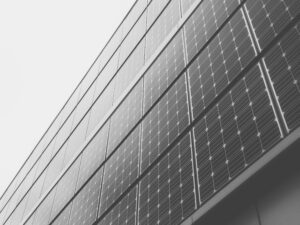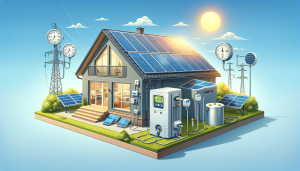Imagine being able to power your home or business with clean, renewable energy without the hassle and cost of owning solar panels. Sounds too good to be true? Well, that’s where a Solar Power Purchase Agreement (PPA) comes into play. In a nutshell, a PPA is a financial agreement between a solar power provider and a consumer, allowing the consumer to benefit from solar energy without investing in the infrastructure themselves. It’s a win-win solution that not only benefits the environment but also saves you money in the long run. So let’s dive into the details of what exactly a solar power purchase agreement entails and how it can revolutionize your energy consumption.

Definition of Solar Power Purchase Agreement (PPA)
Explanation of PPA
A solar power purchase agreement (PPA) is a financial agreement between a solar energy provider and a consumer to purchase and utilize solar energy. Under a PPA, the consumer does not own the solar energy system but instead agrees to buy the electricity generated by the system at a predetermined rate. The solar energy provider bears the responsibility of installing, maintaining, and operating the system.
Definition of PPA
A PPA is a contractual arrangement where a solar energy provider installs, owns, and operates a solar energy system on a consumer’s property or elsewhere, while the consumer agrees to purchase the electricity generated by the system over a specified period of time. The provider sells the electricity to the consumer at an agreed-upon rate, usually lower than the retail rate. PPAs are designed to make solar energy accessible to consumers without the need for significant upfront capital investment.
Key Components of a Solar Power Purchase Agreement
Electricity Pricing
One of the crucial components of a PPA is determining the electricity pricing. The rate at which the consumer purchases the solar electricity is typically set through negotiations between both parties. This pricing structure can vary, but it is often based on factors such as the market rate of electricity, the expected electricity generation from the solar system, and the duration of the agreement.
Duration of Agreement
The duration of a PPA is an important consideration for both the solar energy provider and the consumer. Typically, PPAs have a term ranging from 10 to 25 years, depending on various factors such as the life expectancy of the solar system and the consumer’s desired commitment to renewable energy. Longer-term agreements often offer more stable pricing and greater savings over time.
Terms and Conditions
The terms and conditions of a PPA define the rights and responsibilities of both the solar energy provider and the consumer. These may include provisions related to performance guarantees, maintenance responsibilities, insurance coverage, escalation clauses, and dispute resolution mechanisms. It is essential for both parties to carefully review and negotiate these terms to ensure a mutually beneficial agreement.
Performance Guarantees
Performance guarantees are an important aspect of a PPA as they provide assurance to the consumer that the solar energy system will deliver the anticipated electricity generation. The solar energy provider may offer performance guarantees that cover factors such as minimum system uptime, maximum system downtime, and energy output. These guarantees help protect the consumer’s investment and ensure reliable access to solar energy.
Penalties
PPAs often include penalties clauses to address situations where either party fails to fulfill their obligations. These penalties may be imposed if the solar energy system does not meet the specified performance requirements or if the consumer fails to make timely payments. It is important for both parties to understand the penalty provisions and their potential financial implications.
Termination Clause
A termination clause outlines the conditions under which either party can terminate the PPA before the agreed-upon duration. This clause may include provisions related to early termination fees, notice periods, and circumstances that would warrant termination. Consumers should carefully evaluate the termination clause to understand the flexibility and potential consequences of exiting the agreement before its term.

Benefits of a Solar Power Purchase Agreement
Reduced Energy Costs
One of the most significant benefits of a solar PPA is the potential for reduced energy costs. By entering into a PPA, consumers can lock in a fixed or predictable rate for solar electricity, which is often lower than the prevailing retail electricity rates. This allows businesses, institutions, and households to save money on their energy bills and allocate those savings to other areas of their operations or personal lives.
Risk Mitigation
Solar PPAs can help mitigate risks associated with owning and operating a solar energy system. Consumers do not bear the upfront capital costs or the ongoing maintenance and repair expenses. Instead, these responsibilities are assumed by the solar energy provider. This reduces the risks and uncertainties often associated with system performance, ensuring that consumers receive the expected output from the solar energy system without the burden of ownership.
Environmental Sustainability
By adopting a solar PPA, consumers contribute to environmental sustainability efforts. Solar energy is a clean and renewable energy source that does not produce greenhouse gas emissions during generation. Transitioning to solar energy reduces reliance on fossil fuels and supports global efforts to combat climate change. Consumers can enhance their environmental credibility by demonstrating their commitment to sustainable practices through the use of solar power.
Fixed or Predictable Energy Prices
Traditional electricity prices are subject to market fluctuations and can be unpredictable, making budgeting and financial planning challenging. With a solar PPA, consumers can enjoy the benefit of fixed or predictable energy prices for the duration of the agreement. This stability provides peace of mind and allows for better financial forecasting, particularly for businesses and organizations with long-term operational plans.
No Upfront Costs
One of the key advantages of a solar PPA is the absence of significant upfront costs. Consumers can install solar energy systems without having to invest large sums of money in equipment and installation. This makes solar energy accessible to a wide range of consumers, including businesses, non-profit organizations, and residential customers. The financial burden of system ownership is shifted to the solar energy provider, allowing consumers to reap the benefits of solar energy without the capital investment.
How Does a Solar Power Purchase Agreement Work?
Selection of Solar Provider
The first step in implementing a solar PPA is to select a solar energy provider. It is essential to choose a reputable and experienced provider who can meet the consumer’s specific needs. Factors to consider during the selection process include the provider’s track record, financial stability, customer references, and expertise in system design, installation, and maintenance.
Site Analysis
Once a solar energy provider is chosen, a site analysis is conducted to determine the suitability of the consumer’s property for solar energy generation. The analysis assesses factors such as the available roof or ground space, shading, orientation, and potential obstructions. This analysis helps determine the optimal design and capacity of the solar energy system.
Contract Negotiation
After the site analysis, the consumer and the solar energy provider engage in contract negotiations. This includes determining the pricing structure, contract terms, performance guarantees, termination conditions, and any specific requirements or preferences of both parties. The negotiation process should address all aspects of the agreement and ensure a clear understanding and alignment between both parties.
Installation and Commissioning
Once the contract is finalized, the solar energy provider proceeds with the installation and commissioning of the solar energy system. This involves securing permits, procuring equipment, installing panels, and connecting the system to the consumer’s electrical infrastructure. The installation process is typically managed by the solar energy provider, ensuring compliance with quality standards and applicable regulations.
Operations and Maintenance
After the solar energy system is installed and commissioned, the provider assumes responsibility for its ongoing operations and maintenance. This includes regular inspections, cleaning, system monitoring, and any necessary repairs or upgrades. The provider ensures that the system operates optimally to maximize energy generation and fulfill the requirements of the PPA.
Metering and Billing
Metering and billing are crucial components of a solar PPA. The solar energy provider installs a separate meter to measure the solar electricity generated and consumed by the consumer. Based on this metering data, the provider prepares regular invoices reflecting the amount of energy consumed and the agreed-upon rate. Consumers receive a detailed breakdown of their solar electricity usage and corresponding charges.

Types of Solar Power Purchase Agreements
On-Site Solar PPA
An on-site solar PPA involves installing a solar energy system on the consumer’s property. The consumer benefits from the generated solar electricity, reducing their reliance on the grid and lowering their energy costs. This type of PPA is common for businesses, institutions, and residential customers with suitable roof or ground space for solar panel installation.
Off-Site Solar PPA
In an off-site solar PPA, the solar energy system is not installed on the consumer’s property. Instead, the solar panels are located at a separate, often larger-scale, solar farm or facility. The consumer enters into an agreement to purchase the electricity generated by the off-site system. This is suitable for consumers who do not have adequate space for on-site solar installation or prefer to support renewable energy without the physical presence of solar panels on their property.
Virtual or Shared Solar PPA
Virtual or shared solar PPAs allow consumers to purchase a portion of the solar electricity generated from a shared solar facility. Multiple participants contribute to the development and financing of the solar energy system and receive credits or access to a predetermined portion of the energy generated. This type of PPA enables consumers who cannot install solar panels individually to still benefit from solar energy.
Community Solar PPA
Community solar PPAs involve a group of consumers collectively purchasing solar energy from a shared solar facility within their community. Participants in the program receive credits or a discounted rate for the solar electricity they consume, helping them reduce their energy costs and support local renewable energy initiatives. Community solar PPAs promote renewable energy adoption and provide access to solar power to a broader range of consumers.
Utility-Scale Solar PPA
Utility-scale solar PPAs involve large-scale solar energy projects that are typically developed and owned by utility companies or independent solar power producers. The generated solar electricity is sold to utilities or large consumers through long-term PPAs. Utility-scale solar PPAs contribute significantly to expanding renewable energy generation and reducing reliance on fossil fuel-based power sources.
Considerations for Choosing a Solar Power Purchase Agreement
Energy Needs and Consumption
Understanding energy needs and consumption patterns is essential when considering a solar PPA. Consumers should evaluate their historical energy usage and identify areas where solar energy could be effectively incorporated. Assessing peak demand periods and aligning solar generation with high energy consumption can optimize the benefits of a PPA.
Location and Site Suitability
The location and site suitability play a crucial role in the feasibility of a solar PPA. On-site installations require adequate roof or ground space with minimal shading or obstructions. Evaluating the solar resource potential at the site and considering any structural or regulatory limitations are essential steps in determining the viability of a solar energy system.
Financial Analysis and Savings
Conducting a financial analysis is necessary to assess the potential savings and return on investment associated with a solar PPA. Evaluating the current energy costs, the projected electricity price increase, and the estimated savings from utilizing solar energy can help determine the financial viability of a PPA. Consumers should consider the long-term cost benefits and assess the payback period.
Contractual Terms and Conditions
Understanding and reviewing the contractual terms and conditions of a PPA is vital before entering into an agreement. Consumers should carefully assess factors such as contract duration, pricing structure, penalties, termination conditions, performance guarantees, and obligations of both parties. Engaging in thorough due diligence can help avoid any future disputes or challenges.
Solar Provider’s Reputation and Track Record
The reputation and track record of the solar energy provider should be evaluated before finalizing a PPA. Reviews, references, and case studies from previous customers can provide insights into the provider’s reliability, expertise, and customer service. Working with an experienced and reputable provider contributes to a smoother implementation and ensures the long-term success of the PPA.

Risks and Challenges of a Solar Power Purchase Agreement
Performance and Production Risk
Performance and production risk are inherent in any solar PPA. Factors such as fluctuations in solar irradiance, equipment failures, or suboptimal system design can lead to variations in energy generation. Consumers should ensure that the PPA includes performance guarantees and penalties for underperformance to mitigate the risk of not achieving the expected energy production levels.
Early Termination and Penalty
Early termination of a solar PPA may result in penalties or fees, depending on the agreement’s terms and conditions. Consumers should carefully evaluate the termination clause and the associated financial implications before signing the contract. Unforeseen circumstances or changes in the consumer’s energy needs or financial situation may prompt early termination, so it is important to assess the flexibility of the agreement.
Regulatory Changes
Government policies and regulations related to solar energy can impact the financial viability and feasibility of a solar PPA. Changes in feed-in tariffs, net metering policies, or tax incentives can directly affect the economics of the agreement. Consumers should stay informed about relevant regulatory developments and assess their potential impact on the PPA.
Transferability
The transferability of a solar PPA is an important consideration, especially for businesses or homeowners who may sell or transfer their property during the agreement’s term. Some PPAs allow for the transfer of the agreement to a new owner, while others may necessitate negotiation or termination. Understanding the transferability provisions beforehand can prevent complications during property transactions.
Limited Control over Solar System
With a solar PPA, consumers do not have ownership or direct control over the solar energy system. While this reduces maintenance responsibilities, it also means that any system upgrades, repairs, or changes must be coordinated with the solar energy provider. Consumers should clearly define their expectations and ensure a communication protocol is in place to address any maintenance or operational concerns.
Comparison with Other Financing Options
Solar Lease
A solar lease is another financing option for accessing solar energy without upfront costs. Unlike a PPA, where the consumer purchases the generated electricity, a solar lease allows the consumer to lease the solar energy system itself. The consumer pays a fixed monthly lease payment for the use of the system, and any electricity generated is typically consumed at a predetermined rate. Solar leases often involve longer terms and may not offer the same level of cost savings as a PPA.
Solar Loan
A solar loan is a financing option where the consumer borrows money to purchase a solar energy system. Unlike a PPA or solar lease, the consumer becomes the owner of the system and is responsible for maintenance and operation. Solar loans provide an opportunity for consumers to benefit from long-term energy cost savings and potential tax incentives. However, they require upfront capital or the ability to secure a loan.
Power Purchase Agreement vs. Solar Lease
PPAs and solar leases share certain similarities, such as allowing consumers to access solar energy without upfront costs. However, the key difference lies in what is being financed. With a PPA, the consumer purchases the electricity generated by the system, while with a solar lease, the consumer leases the equipment itself. PPAs often offer greater potential savings over time, while solar leases provide fixed monthly payments without the benefit of benefiting from the electricity sold back to the grid.
Power Purchase Agreement vs. Solar Loan
The main distinction between a PPA and a solar loan lies in system ownership. With a PPA, the solar energy provider retains ownership and responsibility for the system, while the consumer only purchases the electricity generated. In contrast, a solar loan allows the consumer to own the system outright but requires the upfront capital or financing to purchase the equipment. PPAs are ideal for consumers who prefer to avoid the financial burden of ownership, while solar loans provide the opportunity for long-term savings and increased flexibility.
Case Studies of Successful Solar Power Purchase Agreement Implementations
Corporate Sector
Numerous corporations have adopted solar PPAs to meet their sustainability goals and reduce their carbon footprint. Companies such as Google, Apple, and Walmart have entered into large-scale PPAs, investing in solar energy systems to power their operations. These PPAs have allowed these corporations to benefit from renewable energy, stabilize their energy costs, and demonstrate their commitment to sustainability to stakeholders.
Utilities
Utility companies have also embraced solar PPAs as a means of diversifying their energy sources and complying with renewable energy mandates. For example, NV Energy, a utility in Nevada, has signed multiple PPAs to develop large-scale solar projects, providing clean energy to its customers. These PPAs have helped the utility reduce its reliance on fossil fuels and support the growth of renewable energy in the region.
Municipalities and Public Institutions
Cities and public institutions have utilized solar PPAs to achieve cost savings and enhance their sustainability efforts. The City of San Diego, California, has entered into a PPA to power its municipal facilities with solar energy. This PPA has allowed the city to reduce greenhouse gas emissions, lower energy costs, and create local job opportunities in the renewable energy sector.
Non-Profit Organizations
Non-profit organizations, including educational institutions and healthcare facilities, have leveraged solar PPAs to reduce their operating costs and promote environmental stewardship. The George Washington University in Washington, D.C., has implemented a PPA to generate solar energy on its campus. This PPA has not only helped the university achieve its sustainability goals but has also provided educational opportunities for students to learn about renewable energy.
Future Trends and Outlook for Solar Power Purchase Agreements
Increasing Adoption
The adoption of solar PPAs is expected to continue increasing, driven by the declining costs of solar energy and the growing demand for clean energy. Businesses, municipalities, and individual consumers are recognizing the financial and environmental benefits of solar PPAs, leading to a broader acceptance and adoption of this financing model.
Advancements in Technology
Advancements in solar technology, including improvements in panel efficiency, energy storage capabilities, and system design, will further enhance the appeal of solar PPAs. These advancements will increase the feasibility of solar energy systems, improve energy generation predictability, and potentially reduce the overall costs associated with solar installations.
Policy and Regulatory Support
Government policies and regulatory frameworks play a vital role in shaping the future of solar PPAs. Continued support through incentives, tax credits, and favorable net metering policies can facilitate the adoption of solar energy and encourage the development of more PPAs. Policy stability and long-term commitment to renewable energy will further drive the growth of solar PPAs.
Financial Innovations
Financial innovations in the renewable energy sector, such as securitization and green bonds, can provide additional funding options for solar PPAs. These mechanisms enable the pooling of solar PPAs into financial products, attracting institutional and retail investors and expanding the availability of capital for solar projects. As these financing options evolve, more consumers may have access to PPAs without incurring high upfront costs.
Potential Challenges and Opportunities
While solar PPAs offer numerous benefits, there are potential challenges and opportunities that lie ahead. Challenges include adapting PPAs to changing energy market landscapes, navigating complex regulatory environments, and addressing technology-related risks. However, opportunities arise in the form of innovative pricing structures, advancements in energy storage, expansion into emerging markets, and collaboration between stakeholders to scale up solar PPAs globally.



